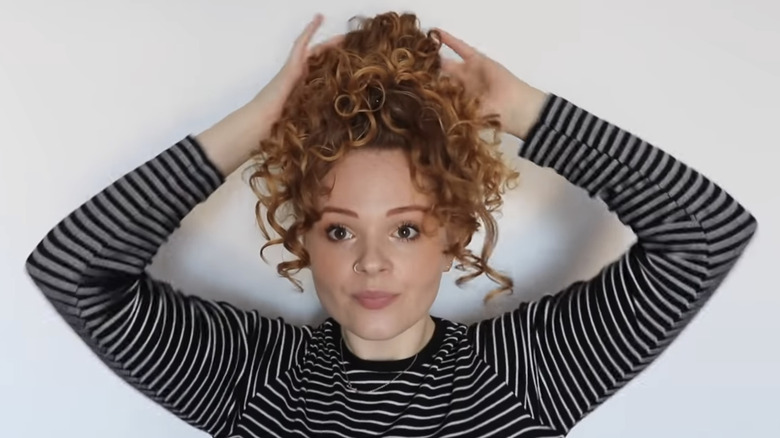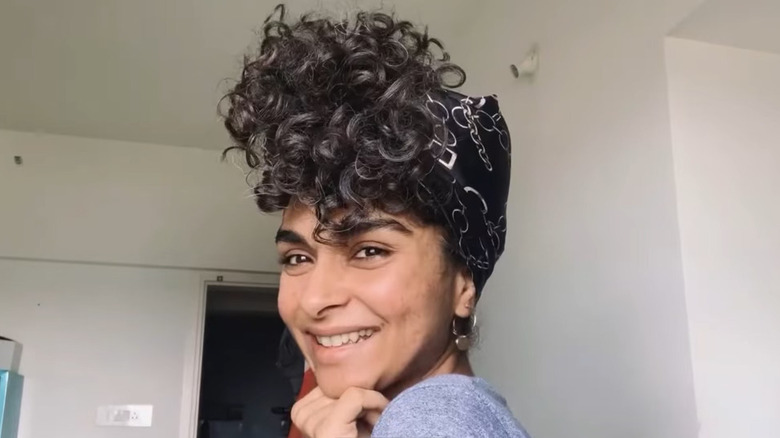Why Pineappling Is The Technique You Need To Try If You Have Curly Hair
Curly hair is undoubtedly gorgeous, but it can also be a lot of work to maintain. While there are hair care tips that everyone can benefit from like keeping your hair moisturized or combating dandruff, the American Academy of Dermatology (AAD) has specific recommendations for those with curly hair.
It's not uncommon to skip a hair-washing day here and there but for curly-haired folks, it's important to reduce the frequency of hair-washing more drastically. Ideally, shampooing once every two to three weeks would help reduce frizz, breakage, and tangles in your curls. Since curly hair is more prone to knots, utilizing leave-in conditioners and combing out tangles when it's wet is recommended since brushing dry curls will likely lead to damage. Although curly hair looks absolutely beautiful in the sun, the AAD recommends those with curly hair cover up their luscious locks so they stay moisturized and don't get dried out from the heat.
When it comes to bedtime, sleeping can unleash a new world of hair struggles depending on multiple factors. The secrets to sleeping with straight hair can seem quite simple when compared to curly hair. However, there is a hack that the curly hair community swears by called pineappling and it's one of the best things you can do for your curly hair at night.
Sleeping with curly hair
According to Garnier, pineappling is a method of protecting curly hair while you sleep that involves loosely tying a hair scrunchy around your curls at the top of your head, and then allowing those curls to fall to either side like the top of a pineapple. Of course, there is some prep work that goes into your hair before it's time to crawl into bed.
Once you prep your curls with an anti-frizz leave-in conditioner and all of the products in your nighttime hair care routine, it's time to gather your hair in a high ponytail. The key is a loose scrunchie — as loose as possible. The tighter the hair band the more of a ring it will leave on your hair in the morning. The pineappling technique keeps the curls away from the back of your head so you don't lay on them while you sleep. It's also recommended that those with curly hair sleep on a pillowcase with silk or satin because that can help reduce hair frizz in the morning.
It's also important to know what to avoid after pineappling your hair. After waking up in the morning and gently sliding the scrunchy off of your curls, do not run your fingers through your hair or brush it. This can cause a major frizz fest. Instead, gently shake your head to the left and right to give your hair some natural bounce, and feel free to spray on any of the daytime hair products you typically reach for.
What about short hair?
While pineappling your hair when you sleep is a great way to get multiple days of wear out of your curls, it can leave those with short hair at a loss. If you have curly hair but it's not long enough to fit into a high ponytail, there are still some great options.
According to Naturally Curly, there are ways to protect your shorter curls while you sleep. The first option is something called mini pineappling in which you divide your hair into smaller sections and use tiny scrunchies or jaw clips to keep those curls at the top of your head. This technique may take some practice because you don't want the placement of the clips to be uncomfortable while you sleep.
A silk scarf or bonnet can also be a wonderful accessory for shorter curls. Glamour explains that bonnets are known for protecting hair while you sleep, reducing split ends, and combating hair frizziness. There are many sleep options out there for those with curly hair and taking a little bit of extra time at night will only make getting ready in the morning that much easier.

